Feb 2, 2021 | Environment, Poverty & Equity, Risk and resilience, Young Scientists
By Prakash Khadka, IIASA Guest Research Assistant and Wei Liu, Guest Research Scholar in the IIASA Equity and Justice Research Group
Prakash Khadka and Wei Liu explain how unbridled, unplanned infrastructure expansion in Nepal is increasing the risk of landslides.
Worldwide, mountains cover a quarter of total land area and are home to 12% of the world’s population, most of whom live in developing countries. Overpopulation and the unsustainable use of these fragile landscapes often result in a vicious cycle of natural disaster and poverty. Protecting, restoring, and sustainably using mountain landscapes is an important component of Sustainable Development Goal 15 ̶ Life on Land ̶ and the key is to strike a balance between development and disaster risk management.
Nepal is among the world’s most mountainous countries and faces the daunting challenge of landslides and flood risk. Landslide events and fatalities have been increasing dramatically in the country due to a complex combination of earthquakes, climate change, and land use, especially the construction of informal roads that destabilize slopes during the monsoon.
According to Nepal government data, 476 incidents of landslides and 293 fatalities were recorded during the 2020 monsoon season – the highest number in the last ten years, mostly triggered by high-intensity rainfall – a trend which is increasing due to climate variations. According to one study, by mid-July 2020, the number of fatal landslides for the year had already exceeded the average annual total for 2004–2019.
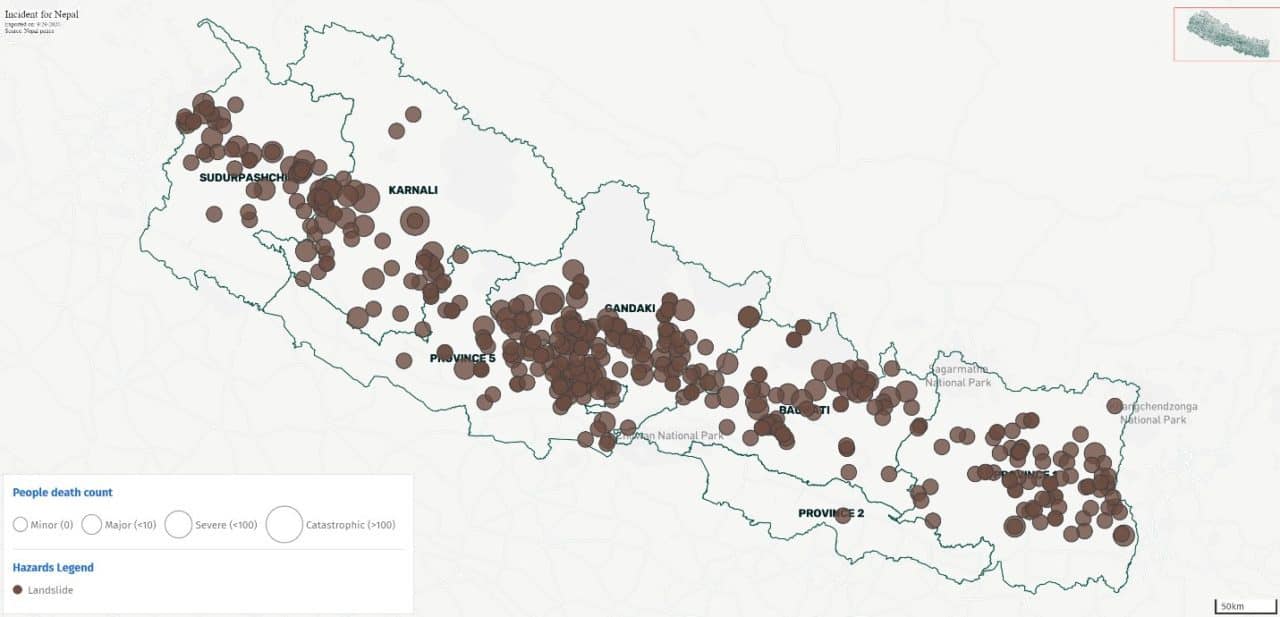
Figure 1: A map of landslide events in Nepal from June to September 2020. Source: bipadportal.gov.np
Landslides are not a new phenomenon in the country where hills and mountains cover nearly 83% of the total land area. While being destructive, landslides are complex natural processes of land development. The Gangetic plain, situated in the foothills of the Himalayas, was formed by the great Himalayan river system to which soil is continually added by landslides and deposited at the base by rivers. Mountain land changes via natural geo-tectonic and ecological processes has been happening for millions of years, but fast population growth and climate change in recent decades substantially altered the fate of these mountain landscapes. Road expansion, often in the name of development, plays a key role.
Many mountain areas in Nepal are physically and economically marginalized and efforts to improve access are common. Poverty, food insecurity, and social inequity are severe, and many rural laborers opt to migrate for better economic opportunities. This motivates road network expansion. Since the turn of the century, Nepalese road networks has almost quadrupled to the current level of ~50 km per 100 km2, among which rural roads (fair-weather roads) increased more than blacktop and gravel roads.

Figure 2: Mountains carved just above Jay Prithvi Highway in Bajhang district of Sudurpaschim province to build a road
Nepalese mountain roads are treacherous and subject to accidents and landslides. Rural roads, which are often called “dozer roads”, are constructed by bulldozer owners in collaboration with politicians at the request of communities (also as part of the election manifesto in which politicians promised road access in exchange for votes and support to win), often without proper technical guidance, surveying, drainage, or structural protection measures. In addition, mountains are sometimes damaged by heavy earthmovers (so-called “bulldozer terrorism”) that cut out roads that lead from nowhere to nowhere, or where no roads are needed, at the expense of economic and environmental degradation. Such rapid and ineffective road expansion happens throughout the country, particularly in the middle hills where roads are known to be the major manmade driver of landslides.
To tackle these complexities, we need to rethink how we approach development in light of climate change. This has to be done with sufficient investigation into our past actions. The Nepalese Community forestry management program, which emerged as one of the big success stories in the world, encompasses well defined policies, institutions, and practices. The program is hailed as a sustainable development success with almost one-third of the country’s forests (1.6 million hectares) currently managed by community forest user groups representing over a third of the country’s households. Another successful example is the innovation of ropeways and its introduction in the Bhattedanda region South of Kathmandu. The ropeways were instrumental in transforming farmers’ lives and livelihoods by connecting them with markets. Locals quickly mastered the operation and management of the ropeway technology, which was a lifesaver following the 2002 rainfall that washed away the road that had made the ropeway redundant until then.
These two examples show that it is possible to generate ecological livelihoods for several households in Nepal without adversely affecting land use and land cover, which in turn contributes to increased landslide risk in the country, as mentioned above.
A rugged landscape is the greatest hindrance to the remote communities in a mountainous country like Nepal. It cannot be denied that the country needs roads that serve as the main arteries for development, while local innovations like ropeways can well complement the roads with great benefits, by linking remote mountain villages to the markets to foster economic activities and reduce poverty. Such a hybrid transportation model is more sustainable economically as well as environmentally.
It is a pity that despite strong evidence of the cost-effectiveness of alternative local solutions, Nepal’s development is still mainly driven by “dozer constructed roads”. Mountain lives and livelihoods will remain at risk of landslides until development tools become more diverse and compatible.
References:
- Gyawali, D. (Ed.), Thompson, M. (Ed.), Verweij, M. (Ed.). (2017). Aid, Technology and Development. London: Routledge, https://doi.org/10.4324/9781315621630
- Gyawali, Dipak; Dixit, Ajaya; Upadhya, Madhukar (2004). Ropeways in Nepal.
- Petley, D. N. (2020). The deadly start to the monsoon season in Nepal – The Landslide Blog – AGU Blogosphere. The Landslide Blog. https://blogs.agu.org/landslideblog/2020/07/24/nepal-2020/
Note: This article gives the views of the author, and not the position of the Nexus blog, nor of the International Institute for Applied Systems Analysis.
Jan 20, 2021 | Energy & Climate, Poverty & Equity, Sustainable Development, Women in Science
By Shonali Pachauri, Research Group leader, Transformative Institutional and Social Solutions
Shonali Pachauri discusses a new framework developed at IIASA to more accurately identify the energy poor.
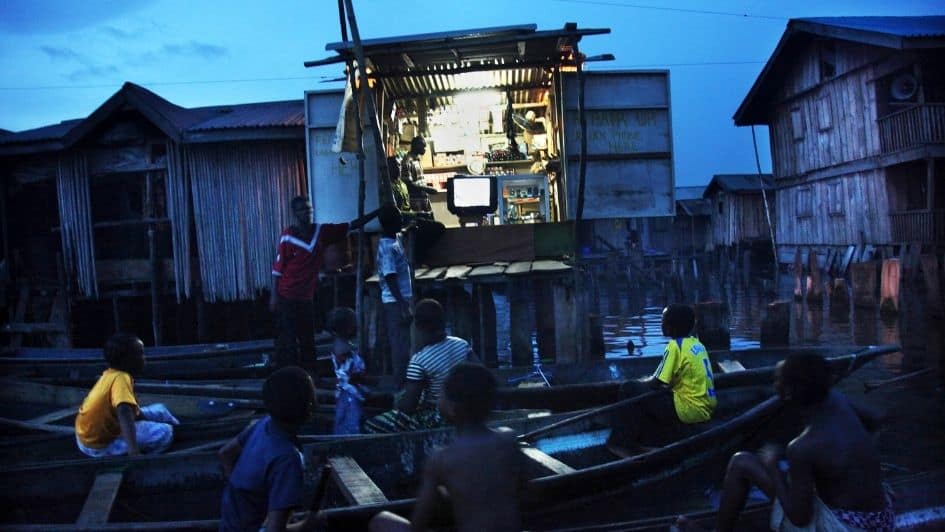
PowerForAll
Energy is a prerequisite for economic and social development. Today, it is widely believed that there are 840 million people still living without electricity in Africa and Asia, while many more are without access to reliable power. And because of COVID-19, this number is growing again.
But what if this data, which governments and donors rely on to allocate money and shape policy, are flawed? And what if we’re even further from eradicating energy poverty than we think? This is the conclusion of a new framework for counting energy access.
The United Nations uses a simple indicator of the share of population with electricity connections to measure energy access. But this grossly underestimates the number of energy poor, because it considers a household to have access even if they receive irregular quality and hours of electricity supply or are unable to afford anything beyond an electric light.
Recent efforts to improve how we measure energy poverty have made vast improvements but have now resulted in frameworks that are complicated and “data needy”, therefore difficult to scale up to a global level.
A new framework developed by IIASA builds on existing measurement frameworks, but simplifies and advances these to more accurately identify the energy poor. It has already been applied to actual data from Ethiopia, India, and Rwanda to test how well it captures energy poverty in comparison to the World Bank’s Multi-Tier Framework (MTF).
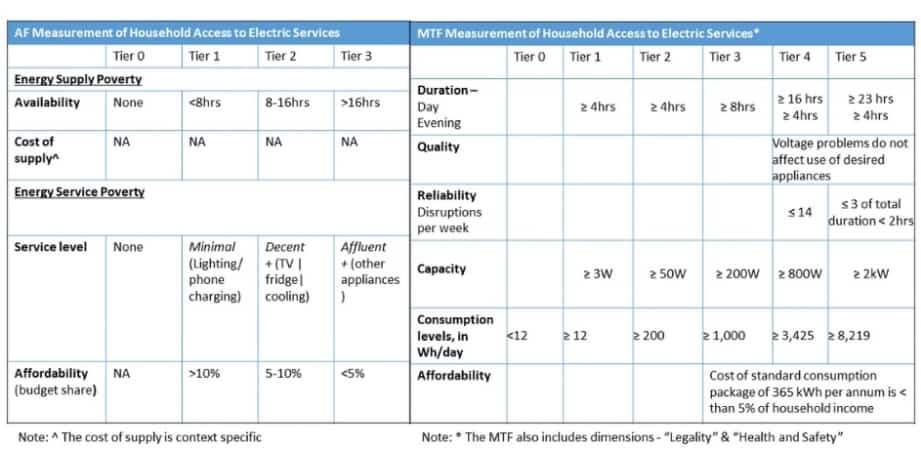
The framework distinguishes between two aspects of access: the quality of power supply and the circumstances of the end-user. This distinction is important to better direct policy efforts where they are most needed, that is, to energy suppliers and/or to households. It also reduces the number of dimensions and tiers to simplify the MTF.
Instead of correlating energy consumption with energy access, a key advancement of the new framework is using ownership of different types of appliances as a proxy for measuring household amenities and services derived from the use of these appliances to improve wellbeing. Electricity consumption is a misleading measure of energy service, because for those who use inefficient appliances, more consumption does not translate into more service. For instance, a household using six inefficient light bulbs is not better off than one that uses three efficient high luminosity light points and an efficient fan that provides comfort from the summer heat. The framework also improves on how affordability is measured to consider appliance purchase costs in addition to recurrent electricity expenditures in assessing the budget share spent on electric services.
When applied to real data, the framework suggests that the energy poor are more segmented than what is reflected by existing binary or MTF indicators. The categorization of households according to electricity consumption differs markedly from that according to energy services and using appliance ownership, revealing greater heterogeneity among the energy poor than what is reflected in the MTF’s consumption-based indicator.
In addition, the new framework shows that affordability is even more of a constraint to gaining access to modern electric services for households in Ethiopia, India, and Rwanda than reflected by the MTF. According to the MTF’s indicator of affordability, practically no one in Ethiopia or India would be considered unable to afford electricity access. However, if one includes the discounted cost of appliances needed to consume electricity in the indicator, about a third of the population in India and Ethiopia might be categorized as facing issues with affordability. In Rwanda, even without considering the discounted cost of appliances, most electricity consuming households are faced with affordability constraints to using basic electric services at home.
This evolution of measuring energy access is just a first step to more accurately counting the energy poor. This needs to go hand in hand with better data gathering, especially for countries and regions that face the biggest challenges in terms of extending access to modern energy services. Further refinements and applications of the framework can help improve how we identify the most vulnerable and design and target policies to achieve true energy access for all.
This blog post was first published on the PowerForAll Energy policy website. Read the original article here.
Note: This article gives the views of the author, and not the position of the Nexus blog, nor of the International Institute for Applied Systems Analysis.
Oct 2, 2020 | Climate Change, Economics, Food, Poverty & Equity
By Charlotte Janssens, guest researcher in the IIASA Ecosystems Services and Management Program and researcher at the University of Leuven and Petr Havlík, Acting Ecosystems Services and Management Program Director.
Charlotte Janssens and Petr Havlik write about their recent study in which they found that world trade can relieve regional impacts of climate change on food production and provide a way to reduce the risk of hunger.
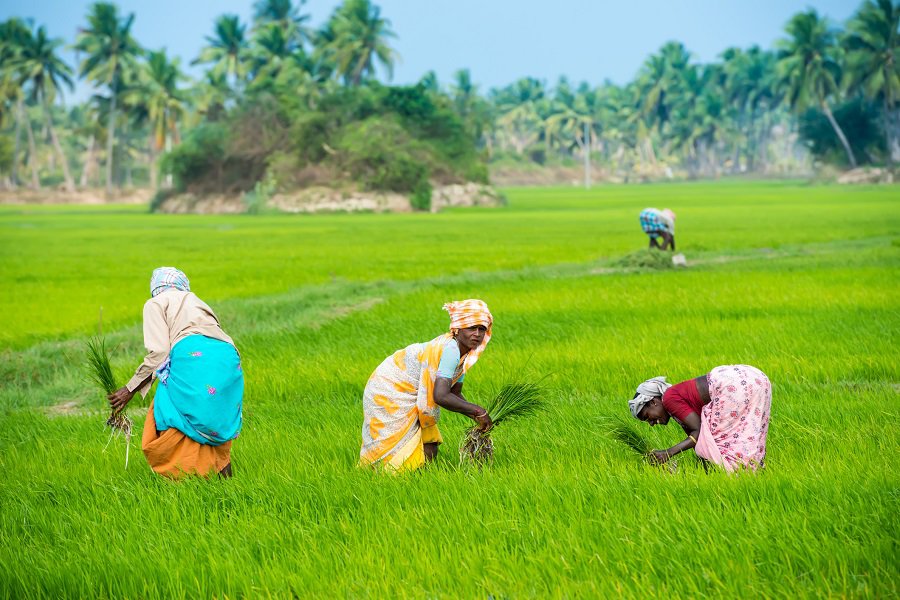
© Alisali | Dreamstime.com
In a warmer world, decreasing crop yields and rising food prices are expected to strongly jeopardize the achievement of Sustainable Development Goal (SDG) 2 – ending global hunger. Climate change has consequences for food production worldwide, but there are clear differences between regions. Sufficient food is expected to remain available in the Northern hemisphere, while in regions such as sub-Saharan Africa or South Asia, falling crop yields may lead to higher food prices and a sharp rise in hunger.
In our recent publication in Nature Climate Change, we find that world trade can relieve these regional differences and provide a way to reduce hunger risks under climate change. For example, if regions like Europe and Latin America where wheat and corn thrive increase their production and export food to regions under heavy pressure from the warming of the Earth, food shortages can be reduced.
Global Hunger by 2050
The State of Food and Nutrition Security in the World 2020 reports that globally almost 690 million people were at risk of hunger in 2019. Many factors determine how global hunger will develop in the future, including population growth and economic development, as demonstrated in a study in Environmental Research Letters. Our article uses the “middle-of-the-road” socioeconomic pathway where population reaches 9.2 billion, income grows according to historical trends, and the number of undernourished people decreases to 122 million by 2050. Within this socioeconomic setting, we investigate the impact of different climate change scenarios and trade policies on global hunger by 2050.
The worst-case climate scenario of a 4°C warming leads to an extra 55 million people enduring hunger – a 45% increase compared to the situation without climate change. In a protectionist trade environment where vulnerable regions cannot increase their food imports as a response to climate impacts, this effect rises to 73 million. The largest hunger risks are located in South Asia and sub-Saharan Africa, with respectively a 33 million and 15 million increase in people at risk of hunger in the worst-case climate scenario.
Where barriers to trade are eliminated, “only” 20 million people endure food shortages due to climate change. While this number is high, it is a vast improvement on the 73 million people that would potentially be exposed to hunger without the suggested measures. In the milder climate change scenarios, an intensive liberalization of trade may prevent even more people from enduring hunger owing to global warming. Yet a liberalization of international trade may also involve potential dangers. If Asian countries increase rice exports without making more imports of other products possible, they could well end up with a food shortage within their own borders.
Mobilizing Investment
Our study shows not only that the challenge of ending global hunger is strongly determined by the extent of progress on SDG 13 (climate action), but also that achievement of SDG 2 (zero hunger) is affected by developments articulated in SDG 9 (resilient infrastructure). We find that international trade can relieve regional food shortages and reduce hunger, particularly where trade barriers are eliminated. Such trade integration requires phasing out import tariffs as well as the facilitation of trade through investment in transport infrastructure and technology. Especially in low-income regions such as sub-Saharan Africa infrastructure is weak. In its 2018 African Economic Outlook, the African Development Bank (AfDB) estimates that between USD 130 billion and 170 billion a year is needed to bridge the infrastructure gap in the region by 2025. Given that infrastructure finance averaged only USD 75 billion in recent years, and the largest contribution is coming from budget-constrained national governments, alternative financing through institutional and private investments could be crucial in the face of climate change.
Crisis and Protectionism
In times of crisis, countries are inclined to adopt a protectionist stance. For example, in the face of the current COVID-19 pandemic, several countries have temporarily closed their borders for the export of important food crops (see IFPRI Food Trade Policy Tracker for updated information). Some commentators warn that such measures can have large detrimental effects on food security. Our study finds that also in the context of climate change, a well-thought-out liberalization of trade is needed in order to be able to relieve food shortages properly.
Reference
Janssens C, Havlík P, Krisztin T, Baker J, Frank S, Hasegawa T, Leclère D, Ohrel S, et al. (2020). Global hunger and climate change adaptation through international trade.
Nature Climate Change [
pure.iiasa.ac.at/16575]
This blog post first appeared on the SDG Knowledge Hub website. Read the original post here.
Note: This article gives the views of the authors, and not the position of the Nexus blog, nor of the International Institute for Applied Systems Analysis.
Feb 28, 2020 | Air Pollution, Alumni, India, Poverty & Equity, Young Scientists
By Abhishek Kar, Postdoctoral Research Scientist at Columbia University, USA, and IIASA Young Scientists Summer Program (YSSP) alumnus.
Abhishek Kar shares his thoughts on the Indian government’s Ujjwala program, which aims to scale up household access to Liquefied Petroleum Gas (LPG) for clean cooking.
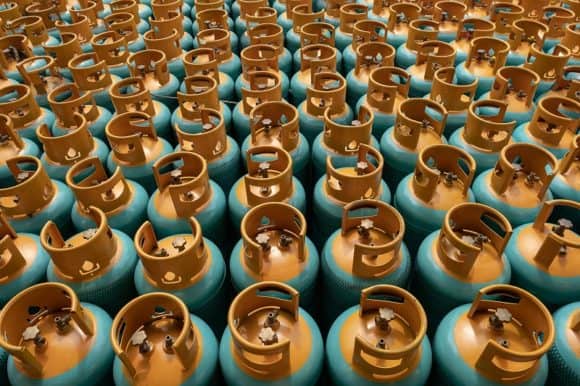
© Kaiskynet | Dreamstime.com
About 2.9 billion people depend on burning traditional fuels like firewood rather than modern cooking fuels like gas and electricity to cook their daily meals. The household air pollution caused when these fuels are burned, along with the resultant exposure to kitchen smoke causes several respiratory and other diseases. It is estimated that between 2 and 3.6 million people die every year due to lack of access to clean cooking fuels. It also has severe environmental effects like forest degradation and contributes to climate change. To address these challenges, the Indian Government launched a massive program called Pradhan Mantri Ujjwala Yojana (PMUY, or Ujjwala) to scale up household access to Liquefied Petroleum Gas (LPG) in May 2016.
My IIASA Young Scientists Summer Program (YSSP) project under Shonali Pachauri’s supervision was about analyzing consumption patterns of LPG in rural India. We looked at whether there was any differences in consumption patterns between the Ujjwala beneficiaries and general consumers. The analysis formed part of my PhD research and was eventually published as the cover story for the September 2019 issue of the journal, Nature Energy. The journal also invited us to write a policy brief, which was published in January 2020. The study’s findings received widespread media attention, especially in India. When I talk to journalists, they often ask whether the Ujjwala program is a success or a failure. I would like to use this opportunity to clear common misconceptions and share my thoughts.
The Ujjwala program’s original mandate was to tackle the challenge of “lack of access to clean fuel” and to make LPG affordable for poor women. The program provided capital subsidies to this end. Unfortunately, the policy document neither discussed usage of LPG as an exclusive or primary cooking fuel, nor did it provide any incentive for regular use (barring the universal LPG cylinder subsidy that is provided to everyone). The program was ambitious in terms of both scale and timeline, and fulfilled its original aim of providing LPG connections for millions of poor women.
Current debates around the program’s failure to result in smokeless kitchens are happening only because Ujjwala succeeded in fulfilling its original mandate of ensuring physical access. In my opinion, it is truly a remarkable achievement to have reached out to 80 million poor women within 40 months. The process not only involved massive awareness generation and community mobilization, but also ramping up the supply chain to meet increased demand. While I have a lot to say about how Ujjwala can be improved, I think it would be unfair to call it a failure. Access is the first step towards transition to clean fuels, and at least in this respect, it was an extraordinary success, making it a model of energy access for developing countries.
Our research shows that Ujjwala was able to attract new consumers rapidly, but those consumers did not start using LPG on a regular basis. Based on the literature and my own experience, there are five reasons why regular LPG use is a challenge for Ujjwala consumers, and the scheme did not have any specific provisions to effectively address them.
First, rural communities generally have easy access to free firewood, crop residues, cattle dung, etc. So why would they start paying for commercial fuel, when free fuel is readily available for cooking?
Secondly, Ujjwala (bravely) targeted poor women, who generally have limited disposable cash and seasonal, agriculture linked fluctuations in income. If there is no additional income, what costs would a poor family on an already tight budget have to cut to afford such a regular additional expense? While the program has made a 5 kg cylinder option available in response to this issue, the impact on LPG sales is still unknown.
Thirdly, home delivery of LPG cylinders is a challenge in most rural areas, as the cost of delivery for LPG distributors often outweighs the commission they receive. If there is no delivery option, poor rural families who often don’t have access to transport would need to arrange for a cylinder to be picked up from a far-off retail outlet. Oil Marketing Companies have vigorously been pushing for home delivery, but unless there are explicit incentives for this, the situation is unlikely to improve.
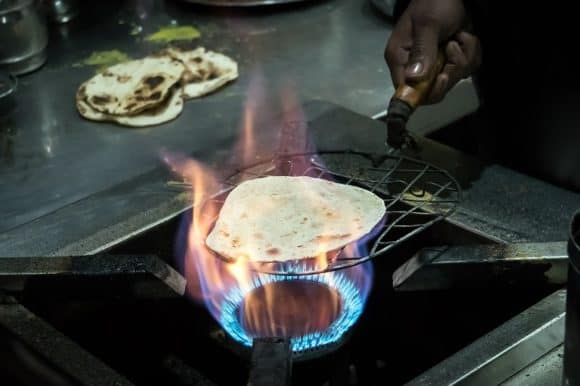
© Dmitrii Melnikov | Dreamstime.com
In the fourth place, gender dynamics make the situation even more complicated. Men are often financial decision makers who have to make budget cuts, while women are the primary beneficiaries of LPG in terms of a quick and smokeless cooking experience, with the side benefit of avoiding the drudgery of fuelwood collection. The laudable effort of the LPG panchayat platform, where women share their success stories and strategies to overcome opposition within their homes, is a step in the right direction, but it is unlikely that this will be sufficient to tackle a deep-rooted societal problem.
Lastly, and perhaps most importantly, people will have to stop using mud stoves and start using LPG stoves, which may involve real (or, perceived) changes in the taste, texture, look, and size of food items. As a student of habit change literature, I am surprised that anyone expected that such a switch would not be accompanied by behavior change interventions.
Ultimately, the Ujjwala scheme provided incentives to reduce the burden of the capital cost of LPG connections, and poor female consumers responded to it positively. This is a successful first step towards clean cooking energy transition. However, there were no scheme incentives to promote use, except general LPG subsidies, which is available to all, including the urban middle class. Consumers simply decided that the transition to LPG through regular purchase of LPG refills was not worth it, and did not take the next step. I would however not call this a failure of Ujjwala, as that was never the original program objective.
We have to acknowledge that Ujjwala’s phenomenal success in providing access to clean fuel has put the spotlight on its ineffectiveness to ensure sustained regular use. If you ask me, this is a classic case of the glass half-full or half-empty scenario. Or, as my PhD supervisor at the University of British Columbia, Hisham Zerrifi, puts it: “It depends!”
References:
[1] Kar A, Pachauri S, Bailis R, & Zerriffi H (2019). Using sales data to assess cooking gas adoption and the impact of India’s Ujjwala program in rural Karnataka. Nature Energy DOI: 10.1038/s41560-019-0429-8 [pure.iiasa.ac.at/15994]
Note: This article gives the views of the author, and not the position of the Nexus blog, nor of the International Institute for Applied Systems Analysis.
May 24, 2019 | Energy & Climate, Poverty & Equity, Sustainable Development
By Pallav Purohit, researcher with the IIASA Air Quality and Greenhouse Gases Program
More than 300 million people in Hindu Kush Himalaya-countries still lack basic access to electricity. Pallav Purohit writes about recent research that looked into how the issue of energy poverty in the region can be addressed.
The Hindu Kush Himalayas is one of the largest mountain systems in the world, covering 4.2 million km2 across eight countries: Afghanistan, Bangladesh, Bhutan, China, India, Myanmar, Nepal, and Pakistan. The region is home to the world’s highest peaks, unique cultures, diverse flora and fauna, and a vast reserve of natural resources.
Ensuring access to affordable, reliable, sustainable, and modern energy for all – the UN’s Sustainable Development Goal (SDG) 7 – has however been especially elusive in this region, where energy poverty is shockingly high. About 80% of the population don’t have access to clean energy and depend on biomass – mostly fuelwood – for both cooking and heating. In fact, over 300 million people in Hindu Kush Himalaya-countries still lack basic access to electricity, while vast hydropower potentials remain largely untapped. Although a large percentage of these energy deprived populations live in rural mountain areas that fall far behind the national access rates, mountain-specific energy access data that reflects the realities of mountain energy poverty barely exists.
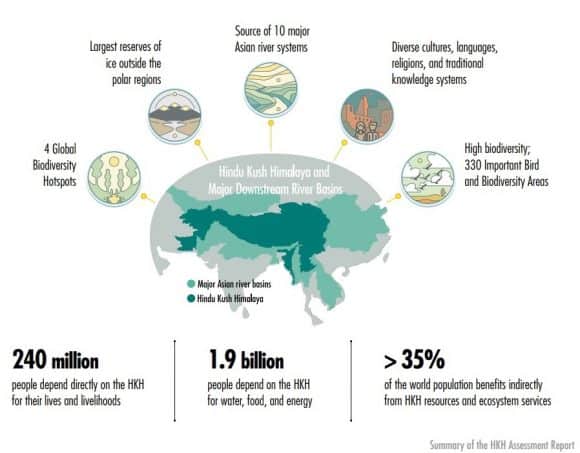
Source: Wester et al. (2019)
The big challenge in this regard is to simultaneously address the issues of energy poverty, energy security, and climate change while attaining multiple SDGs. The growing sectoral interdependencies in energy, climate, water, and food make it crucial for policymakers to understand cross-sectoral policy linkages and their effects at multiple scales. In our research, we critically examined the diverse aspects of the energy outlook of the Hindu Kush Himalayas, including demand-and-supply patterns; national policies, programmes, and institutions; emerging challenges and opportunities; and possible transformational pathways for sustainable energy.
Our recently published results show that the region can attain energy security by tapping into the full potential of hydropower and other renewables. Success, however, will critically depend on removing policy-, institutional-, financial-, and capacity barriers that now perpetuate energy poverty and vulnerability in mountain communities. Measures to enhance energy supply have had less than satisfactory results because of low prioritization and a failure to address the challenges of remoteness and fragility, while inadequate data and analyses are a major barrier to designing context specific interventions.
In the majority of Hindu Kush Himalaya-countries, existing national policy frameworks currently primarily focus on electrification for household lighting, with limited attention paid to energy for clean cooking and heating. A coherent mountain-specific policy framework therefore needs to be well integrated in national development strategies and translated into action. Quantitative targets and quality specifications of alternative energy options based on an explicit recognition of the full costs and benefits of each option, should be the basis for designing policies and prioritizing actions and investments. In this regard, a high-level, empowered, regional mechanism should be established to strengthen regional energy trade and cooperation, with a focus on prioritizing the use of locally available energy resources.
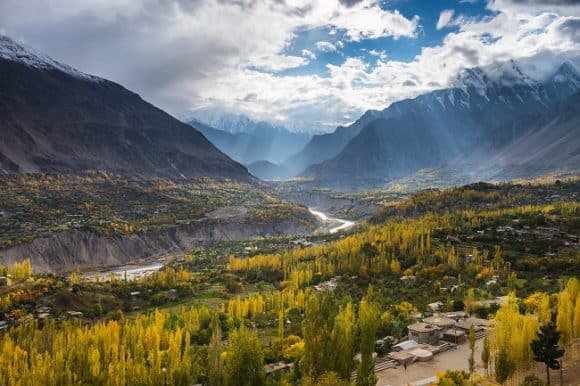
© Kriangkraiwut Boonlom | Dreamstime.com
Some countries in the region have scaled up off-grid initiatives that are globally recognized as successful. We however found that the special challenges faced by mountain communities – especially in terms of economies of scale, inaccessibility, fragility, marginality, access to infrastructure and resources, poverty levels, and capability gaps – thwart the large-scale replication of several best practice innovative business models and off-grid renewable energy solutions that are making inroads into some Hindu Kush Himalayan countries.
This further highlights an urgent need to establish supportive policy, legal, and institutional frameworks as well as innovations in mountain-specific technology and financing. In addition, enhanced multi-stakeholder capacity building at all levels will be needed for the upscaling of successful energy programs in off-grid mountain areas.
Finally, it is important to note that sustainable energy transition is a shared responsibility. To accelerate progress and make it meaningful, all key stakeholders must work together towards a sustainable energy transition. The world needs to engage with the Hindu Kush Himalayas to define an ambitious new energy vision: one that involves building an inclusive green society and economy, with mountain communities enjoying modern, affordable, reliable, and sustainable energy to improve their lives and the environment.
References:
[1] Dhakal S, Srivastava L, Sharma B, Palit D, Mainali B, Nepal R, Purohit P, Goswami A, et al. (2019). Meeting Future Energy Needs in the Hindu Kush Himalaya. In: The Hindu Kush Himalaya Assessment. pp. 167-207 Cham, Switzerland: Springer. ISBN 978-3-319-92287-4 [pure.iiasa.ac.at/15666]
[2] Wester P, Mishra A, Mukherji A, Shrestha AB (2019). The Hindu Kush Himalaya Assessment: Mountains, Climate Change, Sustainability and People. Cham, Switzerland: Springer. ISBN 978-3-319-92287-4.
Note: This article gives the views of the author, and not the position of the Nexus blog, nor of the International Institute for Applied Systems Analysis.
Jul 17, 2018 | Air Pollution, Energy & Climate, Poverty & Equity, Women in Science, Young Scientists
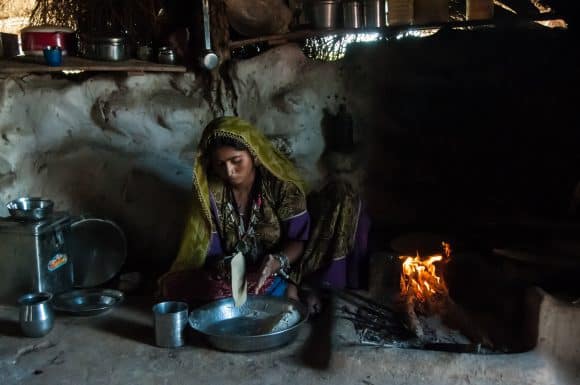
© Stefano Barzellotti | Shutterstock
By Sandra Ortellado, IIASA Science Communication Fellow
When it comes to home cooking in rural India, health, behavior, and technology are essential ingredients.
Consider the government’s three-year campaign to reduce the damaging impacts of solid fuels traditionally used in rural households below the poverty line.
Initiated by the Ministry of Petroleum and Natural Gas, a program called Pradhan Mantri Ujjwala Yojana (Ujjwala) aims to safeguard the health of women and children by providing them access to a clean cooking fuel, liquid petroleum gas (LPG), so that they don’t have to compromise their health in smoky kitchens or wander in unsafe areas collecting firewood.
According to the World Health Organization, smoke inhaled by women and children from unclean fuel is equivalent to burning 400 cigarettes in an hour.
Nevertheless, an estimated 700 million people in India still rely on solid fuels and traditional cooking stoves in their homes. A subsidy of Rs. 1600 (US $23.47) and an interest free loan attempts to offset the discouraging cost of the upfront security deposit, the stove, and the first bottle of LPG, but this measure hasn’t been able to change habits on its own.
Why? Although the government has made an overwhelming effort to increase access, interconnected factors like cultural norms, economic trade-offs, and convenience require an in-depth analysis of human behavior and decision-making.

Abhishek Kar, 2018 YSSP participant ©IIASA
That’s why Abhishek Kar, a researcher in the IIASA Energy Program and a participant in the 2018 Young Scientists Summer Program (YSSP), has designed a study to explore how rural households make choices about access and usage. Borrowing from behavior change and technology adoption theories, he wants to know whether low-cost access is enough incentive for Ujjwala beneficiaries to match the general rural consumption trends, and more importantly, how to translate public perception into a behavior change.
“I think it’s really important to look into the behavioral aspect,” said Kar in an interview. “If you ask someone if they think clean cooking is wise they may say yes, but if you say do you think it is appropriate for you? The moment it becomes personalized the answers can vary.”
Kar knows that although more than 41 million LPG connections have been installed, installment of the connection does not necessarily equate to use. By gathering data on LPG refill purchases and trends, along with surveys that identify biases in the public’s perception, he wants to know how to convince rural BPL households to maintain the habit of using LPG regularly, even under adverse conditions like price hikes. If LPG is used only sporadically, LPG ownership won’t significantly reduce risk for some household air pollution (HAP)-linked deadly diseases, like lower respiratory infections and stroke.
Unfortunately, even the substantial efforts the government has made to improve LPG supply has not changed the public’s perception of its accessibility in the long term, nor its consumption patterns in the first two years. At least four LPG refills per year would be needed for a family of five to use LPG as a primary cooking fuel, which is not currently happening for the majority of Ujjwala customers.
Because the majority of Ujjwala beneficiaries have cost-free access to solid fuels from forest and agricultural fields, there is less incentive for these families to use LPG regularly instead of sporadically. Priority households for Ujjwala, especially those with no working age adults, are often severely economically disadvantaged and can’t afford to buy LPG at regular intervals.
Furthermore, unlike LPG, a traditional mud stove is more versatile and can serve dual purposes of space heating and cooking during winter months. Many prospective customers are also hesitant about the inferior taste of food cooked in LPG, the utility of the mud stove’s smoke as insect repellent, and the trade-off of expenses on tobacco and alcohol with LPG refills.
As per past studies, even the richest 10% of India’s rural households (most with access to LPG) continue to depend on solid fuels to meet ~50% of their cooking energy demand. This suggests that wealth is not the only stumbling block in the transition process.
“Whatever factors matter in the outside world, my working hypothesis is that every decision is finally mediated through a person’s attitude, knowledge, and perceptions of control,” said Kar. According to Kar, interventions can be specifically targeted to address factors that are perceived negatively either by informing people or doing something to improve that factor. Nevertheless, developing effective interventions is no simple task.
Even with a background in physics and management and eight years of experience helping people transition from one technology to another, Kar says he is grateful to have the input of a variety of scholars at IIASA, each with a different perspective and a different set of core skills and experiences. Working in the Energy program alongside IIASA staff and fellow YSSPers from all over the world, Kar puzzles out the unsolved challenge of how to create change for the rural poor.
“That has been one of my drivers, I take it as an intellectual challenge,” said Kar. “Is there a systems approach to the problem?”
For now, Kar is happy if he can return at the end of the day to his family, which he brought with him to Austria during his time as a YSSP participant, feeling like he is opening the door to a vast literature on technology adoption and human behavior, yet untapped in the field of cooking energy access.
“This research is only a very small baby step into trying something different,” said Kar, “I think this sector has so many unanswered questions, if I can at least flag that there is a lot of literature out there in other domains and maybe we can use some of it, I think that would be good enough for me.”
Note: This article gives the views of the author, and not the position of the Nexus blog, nor of the International Institute for Applied Systems Analysis.












You must be logged in to post a comment.